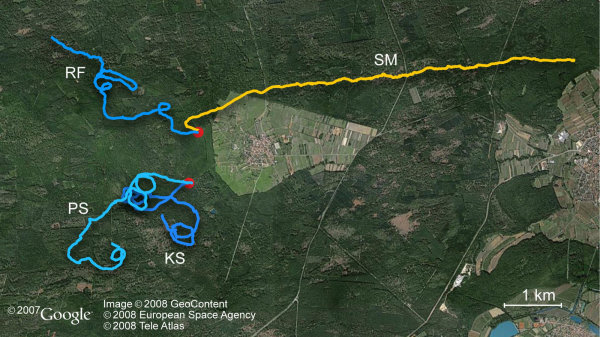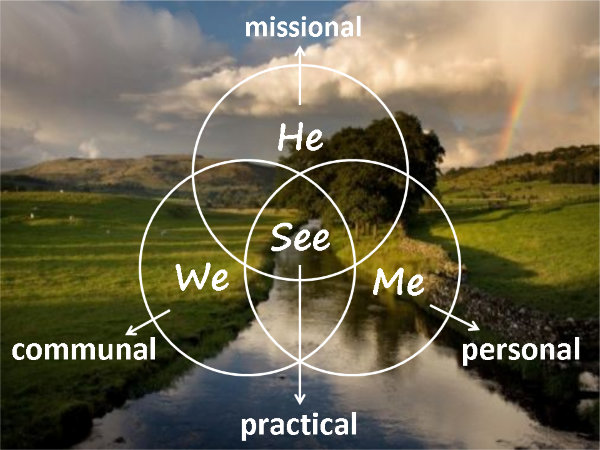Author: Kärin Primuth | Source: visionSynergy
Walking in circles
Did you know that people who are blindfolded will tend to walk in circles?
No one completely understands why human beings do this. If someone is blindfolded or disoriented or even lost in unfamiliar territory, they will often veer off course in random circles, even when they think they are walking in a straight line.
Some have supposed that the phenomenon of walking in circles has something to do with being right-handed or left-handed, or perhaps something to do with having stronger or longer legs on one side or the other. But neither of these explanations has held up to scientific study.
One of the more interesting studies was conducted recently by Jan Souman of the Max Planck Institute for Biological Cybernetics.


Jan Souman / Max Planck Institute for Biological Cybernetics
Souman studied people walking in desert and forest environments. Some of the walkers were blindfolded and some were not. All were told to walk in a straight line as far as they could. The participants in the study walked for hours as their paths were recorded by GPS monitors.
Those who walked blindfolded ended up walking in surprisingly small circles. For those walkers who were not blindfolded, an interesting discovery emerged:
- When the sky was cloudy and the walkers could not see the sun by day or the moon by night, the walkers could not keep a straight line. They veered off course in random directions, crossed their own paths, and walked in circles.
- But when the sky was clear and the sun or moon were visible, the walkers could keep a long straight line for many hours through trackless deserts and vast forests.
This seems to show that when we cannot keep an external reference point, something inside us makes us walk in random circles.
I think this phenomenon is a great metaphor for describing what happens when missional networks and partnerships lack a clear vision.
They begin to go in circles.
Vision is essential
The experience of our team in working with hundreds of networks and partnerships around the world is that a clear, compelling, and commonly-owned vision is absolutely essential. Effective and durable partnerships are driven by a big vision. Partnership merely for the sake of partnership is meaningless. Partnership must have a larger purpose.
God is always calling His people to a bigger vision. I love that passage in Isaiah that says:
It is too small a thing that my servant should only restore to greatness the people of Israel who have survived, but I will also make you a light to the nations – so that all the world will be saved.
Isaiah 49:6
Unfortunately, many people think that partnership is about compromise, especially when we find other people in the mix who may believe or operate a little differently than we do. So people think partnership is about finding the lowest common denominator of what we can agree on and what we can do together.
But actually it is the opposite.
Partnership is not about finding the lowest common denominator.
Partnership is about finding the highest common vision.
Clarifying the vision
One of the primary tasks of a collaborative leader (if not THE primary task) is to help a network or partnership move toward greater clarity about their shared vision. That kind of clarity does not spontaneously appear in a committee meeting. It must be shaped and synthesized and crystallized into words / pictures / symbols / stories that will energize and motivate partners to work together toward that bigger purpose.
Collaborative leaders must also constantly reinforce the vision of the partnership. Remember those people in Souman’s study walking in circles? Those who walked through the desert at night were able to walk in a straight line until the moment when the moon disappeared behind the clouds. Then, without realizing it, they began to walk in circles.
It makes me think of that passage in Habakkuk which says:
I will stand upon my post of observation and station myself on the tower … and will watch to see what He will say within me and what answer I will make to these perplexities … And the Lord answered me and said: ‘Write the vision and engrave it so plainly upon tablets that everyone who passes may be able to read it easily and quickly as he hastens by.’
Habakkuk 2:1-2
Four components of a powerful partnership vision
As you work with your own groups to clarify and articulate what God has called you to do together, here are four components of a powerful partnership vision you may want to keep in mind.
You can use a little rhyme to remember them: He, We, Me, See.

1. He
First of all, the vision is God’s vision. It is missional. When a powerful partnership vision emerges, everyone recognizes that it is really about God’s priorities, not just one individual’s private agenda.
2. We
Secondly, the vision is communal. It is bigger than any one individual. It can only be done together. When a powerful partnership vision emerges, everyone recognizes that God’s purpose is not only to accomplish that dream, but to do it together.
3. Me
Thirdly, the vision is personal. It connects to our individual callings or own ministry priorities. When a powerful partnership vision emerges, each person or each ministry can see how they fit, how they benefit, how they play their part.
4. See
And finally, the vision is practical. It is “do able.” It may be a big vision, but it is something that we can really see happening. When a powerful partnership vision emerges, everyone can visualize the end goal, and the pathways to reaching the goal.
A powerful and sustainable partnership vision lies at the intersection of these four aspects. So as you work to clarify and capture the essence of your collaborative vision and the strategy behind that vision, consider how you can articulate it along these four lines:
- Is your vision missional? Can it clearly connect to a larger purpose?
- Is your vision communal? Can it only be accomplished by working together?
- Is your vision personal? Can each partner see where they fit and why it matters to them?
- Is your vision practical? Can each partner envision both the end goal and the next steps and, ultimately, do they believe that it can really be done?


Hi Lucas,
Thank you for an excellent article and “tool” on vision. A very powerful yet simple diagram with a beautiful graphic — plus a powerful Biblical passage. This type of napkin tool is immediately transferable to any culture, any language and also great for pre literate leaders.
I just joined your Synergy Commons yesterday and want to congratulate you and your talented team for one of the best global networking site I have seen to date.
Oh what a great article it really brings in more clarity thanks
@marvb – Thanks for the compliments about the Commons! It’s good to know this kind of resource seems useful for you. Please feel free to recommend any other resources or tools you think might be of value for this community.
You can post your ideas or suggestions on the Commons support forum:
https://synergycommons.net/forums/topic/recommend-a-resource/
Or you can send a message to:
[email protected]